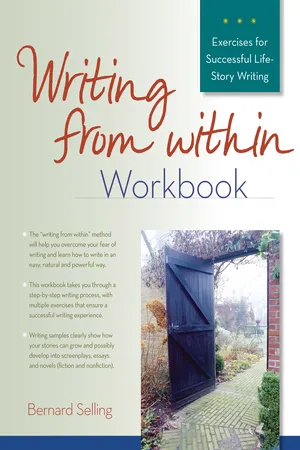
- 144 pages
- English
- ePUB (mobile friendly)
- Available on iOS & Android
Writing from Within Workbook
About this book
Many writing instructors and workbooks make basic assumptions about writing—that you need to have a good grasp of grammar, to read widely, and to write objectively—before you can tell a story. These assumptions are wrong. They invoke fear in would-be writers, who are afraid of being judged and criticized for what they say and how they say it.Bernard Selling, author of Writing from Within and a writing instructor for over 30 years, helps people get over their initial fear of writing with this new Writing from Within Workbook. By writing personal stories, people can usually get past their misconceptions about how someone should write and learn how to write in a way that feels natural and comfortable to them. His comprehensive Workbook takes people through the writing process step-by-step, including lessons on how to add narrative, inner thoughts and feelings, dialogue, character sketches, and climaxes.Once people are familiar with the basics of writing, they can extend their writing skills into other genres without fear. Selling introduces steps that allow readers to broaden their writing into screenplays, essays, fiction, and journals. He explains that the fundamentals of writing are the same, despite the different forms. With the ease and skill of an experienced writing teacher, he helps writers transform their work into whichever form they desire.
Draft samples will show writers how their stories will grow using the Writing from Within method. He comments on each draft, thus demonstrating how to evaluate a piece of writing. These personal notes also help keep readers on track and their goals in perspective. Selling also includes a full chapter of excerpts from past students' stories to show the potential of his method.The completion of this workbook will:
build a love of writing and self-expression in students
create an understanding of what makes a story effective
enable students to apply the principles of storytelling to writing analytical essays
usher students into the world of the 'examined' lifeAll of the techniques that Selling presents are just as relevant to the non-fiction writer as to the fiction writer, and all writers, new and old, will write with more skill. Beyond that, storytelling skills can lead students in two important directions: awareness of the 'self' in their own stories (character) and awareness of relationships between and among other people. Writers will understand themselves and their characters better; they will find their voices, and Selling will help them along the way to doing so.
Frequently asked questions
- Essential is ideal for learners and professionals who enjoy exploring a wide range of subjects. Access the Essential Library with 800,000+ trusted titles and best-sellers across business, personal growth, and the humanities. Includes unlimited reading time and Standard Read Aloud voice.
- Complete: Perfect for advanced learners and researchers needing full, unrestricted access. Unlock 1.4M+ books across hundreds of subjects, including academic and specialized titles. The Complete Plan also includes advanced features like Premium Read Aloud and Research Assistant.
Please note we cannot support devices running on iOS 13 and Android 7 or earlier. Learn more about using the app.
Information
Table of contents
- Cover Image
- Title Page
- Praise for Bernard Selling’s work
- Dedication
- Also by Bernard Selling
- Copyright & Permissions
- Table of Contents
- Preface
- Unit 1: Basic Steps in Life-Story Writing
- Chapter 1: Present-Tense Writing
- Chapter 2: Simplifying Language
- Chapter 3: Adding Feelings
- Chapter 4: Brainstorming to Find Stories
- Chapter 5: Adding Dialogue
- Chapter 6: Uncovering Inner Thoughts and Feelings
- Chapter 7: Writing Thumbnail Sketches
- Chapter 8: Locating the Beginning of the Story
- Chapter 9: Finding The Climax—Sharing an Intense Experience
- Chapter 10: Additional Writing Assignments
- Unit 2: Advanced Steps in Writing Life Stories and Fiction
- Chapter 11: Using Short Sentences
- Chapter 12: Applying the Objective Correlative
- Chapter 13: A “Hitchcockian Recap”
- Chapter 14: Developing Character Qualities
- Chapter 15: Including Backstory
- Chapter 16: Ending with a Denouement
- Chapter 17: Creating Three-Dimensional Minor Characters
- Chapter 18: Creating Visual Motifs
- Chapter 19: Creating Form
- Chapter 20: More on Narrative, Dialogue, and Inner Thoughts and Feelings
- Chapter 21: Employing the Principles of Art
- Chapter 22: Developing Subtext
- Chapter 23: Separating the Writer’s Voice from That of the Central Character
- Unit 3: Family History and Explorations
- Chapter 24: Telling a Family or Family-History Story
- Chapter 25: Researching a Family History
- Unit 4: Turning Stories into Fiction Writing
- Chapter 26: Writing Creative Stories
- Chapter 27: Further Developing Fiction-Writing Skills
- Final Thoughts
- Unit 5: Stories
- Afterword: The Life-Story Writing Workbooks
- Back Cover